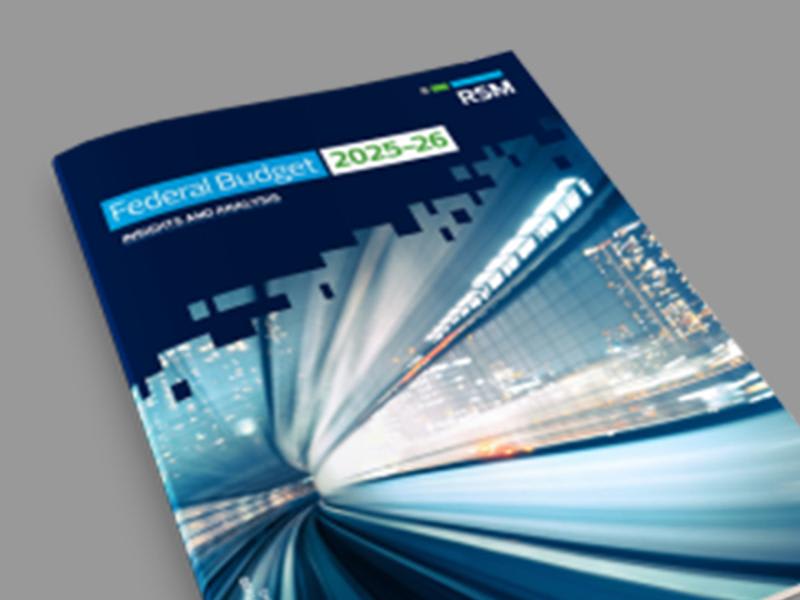Federal Budget 2025-26
INFORMATION FOR Business
The 2025-26 Australian Federal Budget brings a mix of challenges and opportunities for businesses. While some industries see targeted support, most businesses face limited new measures. Here are the key insights from the budget that businesses should know as they plan for the year ahead.
CONTRIBUTOR

Businesses may experience increased competition for retaining their employees due to Budget reforms that abolish non-compete clauses for workers earning less than $175,000. These clauses restrict workers from transitioning to similar positions at other companies or establishing their own businesses in the same industry.
This, along with the fact that one of the Government's key tax measures in the last Budget (the proposed extension of the instant asset write-off measures for 2024-25) is currently still outstanding, will only add to uncertainty.
The only silver lining for SMEs in this year’s Budget are as follows:
- The energy bill relief will be extended to 31 December 2025, with around one million eligible small businesses able to access $150 in rebates, providing up to $800 of energy bill relief since the 2023–24 budget. Small businesses will receive two instalments of $75 before 31 December 2025.
- Extending Unfair Trading Practice protections to small businesses to address the power imbalance when they engage with large businesses.
- Extending protections from Unfair Contract Terms and Unfair Trading Practices to businesses regulated by the Franchising Code of Conduct, including automotive dealers.
- Promoting prompt 20-day payment terms for contractors and subcontractors in the construction industry for work completed for Government Business Enterprises undertaking major construction activity such as NBN Co.
Hospitality venues, Brewers, Distillers, Wine producers.
None.
CONTRIBUTOR
The Government will pause indexation of draught beer excise and customs duty rates from August 2025 to August 2027. These rates usually increase in February and August each year.
Eligible wine producers can receive an extra $50,000 yearly as the Wine Equalisation Tax producer rebate rises from $350,000 to $400,000. Similarly, brewers and distillers will benefit from a $50,000 annual increase under the excise remission scheme for alcoholic beverage manufacturers. Effective 1 July 2026, this measure will raise the caps for all qualifying brewers, distillers, and wine producers to $400,000 per financial year.
Green metal producers
No real Losers except for where demand has been softer than anticipated, funding has been reallocated.
CONTRIBUTOR
This pre-election Budget focussed its attention on cost of living relief measures with a select few grant programs receiving new commitments. These primarily focussed on expanding measures to support the transition to a clean energy future.
Green metals and low-emission technologies
- $2bn over nineteen years for Green Aluminium Production Credits following a similar model announced in previous Budgets for Green Hydrogen production and Critical Minerals processing. The new funding will provide production-based grants to support Australian aluminium producers in switching to renewable electricity before 2036.
- $1bn over seven years for the Green Iron Investment Fund, which will provide capital grants to establish or transition to low-emission facilities. This includes up to $500m for the Whyalla Steelworks.
- A commitment of $2bn to recapitalise the Clean Energy Finance Corporation (CEFC) to invest in renewable energy, energy efficiency and low emissions technologies. Funding has already been allocated for this measure.
Elsewhere, commitments were reaffirmed and the redesign of funding programs announced.
Defence
- $24.2m over two years for the development of industrial initiatives to support the 2024 Naval Shipbuilding and Sustainment Plan and Australia’s ability to build, sustain and operate maritime capability. The Department of Defence will fund this through existing resources.
Support for People with Disability
- $364.5m over five years to redesign the Information, Linkages and Capacity Building Program under the National Disability Insurance Scheme. This will likely lead to new grants and funding opportunities soon.
Community resilience
- $17.7m for the Bushfire Community Recovery and Resilience Program to support bushfire resilience activities in rural and regional Australia
Environment
- $200m over four years for Saving Australia's Bushland Program to provide better pest management and incentives for private land conservation and to establish or expand protected areas.
Casualties
Savings resulted from reversing some previously announced spending. Examples include:
- $75m from the Hydrogen Highways program under the Powering Australia – Driving the Nation Fund.
- $14.7m from reducing funding to the Strategic International Partnerships Investment Stream program












